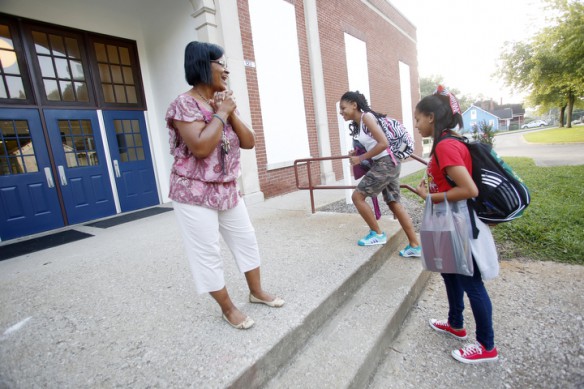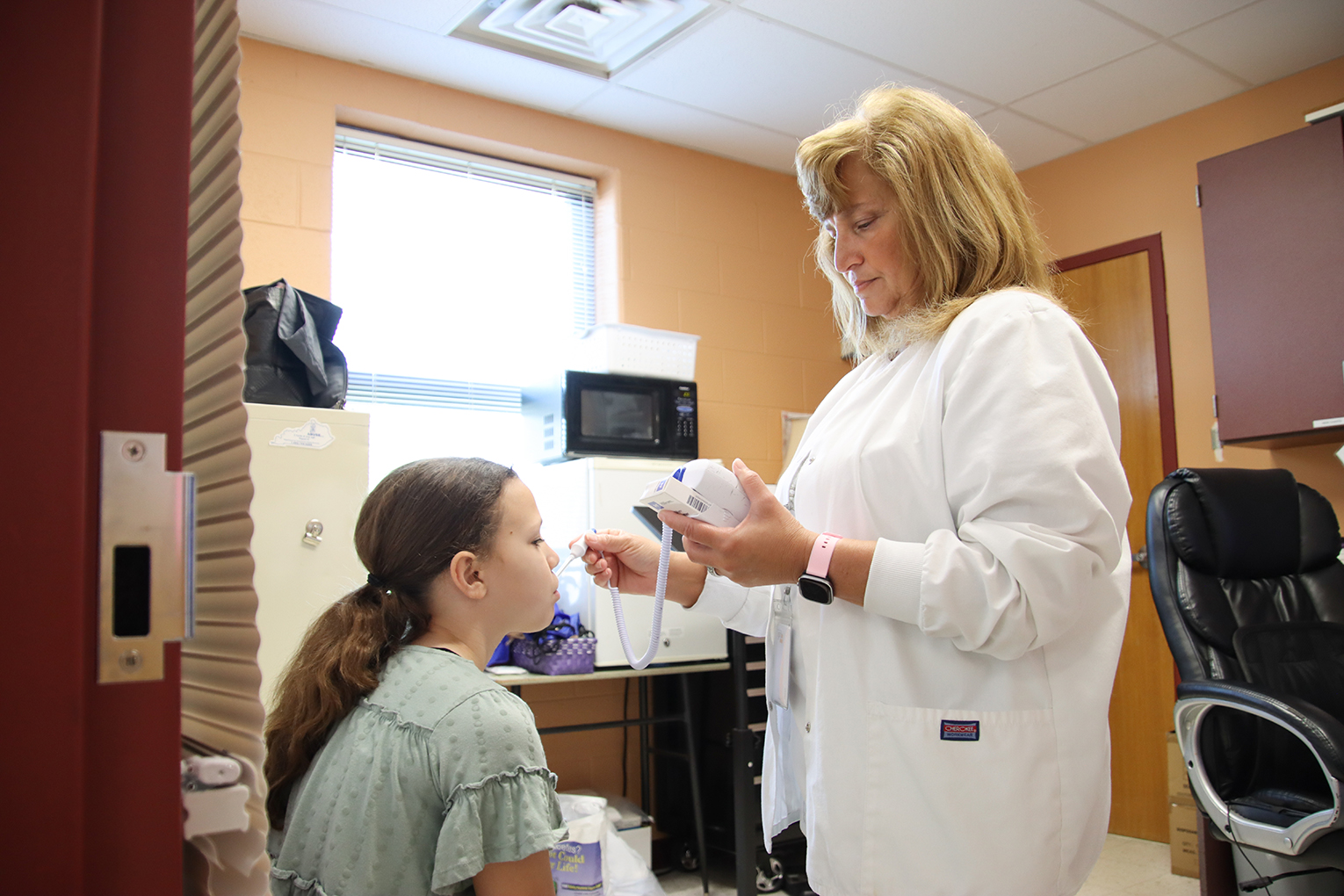
Director Tina Stevenson greets STEAM Academy (Fayette County) students as they arrive at school in the morning. Photo by Amy Wallot, Aug. 21, 2013
By Susan Riddell
susan.riddell@education.ky.gov
When a new school opens, decisions almost always have to be made regarding its identity. What will the mascot be? What about school colors?
For Fayette County school district’s STEAM Academy (STEAM stands for science, technology, engineering, arts and mathematics.), those questions became the central part of the first student lesson.
The STEAM academy opened its doors Aug. 14 to 150 freshmen, and Stevenson said teachers wasted no time in creating opportunities, starting with the school’s identity.
Homerooms spent the first three days working as a team. They couldn’t just come up with schools colors, a logo and a mascot. They had to research it.
“We studied the colors in science, logos in history, graphics in design,” Stevenson said. “Once each room turns in the assignment, students will vote on everything.”
One classroom wanted the mascot to be a gladiator with colors royal blue and silver. Another chose a sabre-toothed tiger because it’s associated with confidence and determination; colors yellow and blue because they represented the sun and the sky as well as characteristics like energy and stability.
“That’s what we do here,” said STEAM Director Tina Stevenson. “It’s all about unique opportunities to embed all of our classes into one another and create interesting learning experiences.”
These community and project-based learning experiences, she said, are designed to lead all STEAM students to college- and career-readiness.
“Everything will work together, especially through design and technology strategies, to get these students ready for college with credit opportunities or career with any certifications they might need.”
Inserting the ‘A’ in STEM
While STEM is a concept that has been well received and fostered in schools for several years now, Stevenson said district administrators felt adding the arts – the “A” needed to create STEAM – was the right call in getting students that much closer to college- and career-readiness and being successful in a global society.
“That arts background goes hand-in-hand with design concepts,” she said. “But the arts isn’t presented traditionally here.”
STEAM has an arts and humanities teacher, but it doesn’t staff an art teacher. Instead, the arts are embedded into every core content class.
“You’ll see lines and segments studied in math class,” Stevenson said. “Social studies will have a lot of ‘Why is this mural important? How does it connect to history?’”
During the first year, students will participate in four design projects. One involves green energy. Another will have students create a musical instrument. Students will study sound and other important concepts in their core classes, before creating their instrument.
“It may not look like a flute, but it’ll sound like a flute,” said Stevenson, who hopes to put together a band concert featuring the student instruments.
“Students will be able to complete this project because we’re tying everything together by implementing core content with the arts.”
Technology engineering teacher Gary DeBorde said he jumped at the chance to teach at the STEAM Academy because of these types of lessons.
“I truly believe in this type of delivery,” DeBorde said. “We learn by doing and that failure is a step stone. I don’t know one child who learned to ride a bike without falling off at some point.”
UK’s role in the STEAM Academy
The STEAM Academy is a partnership between Fayette County Schools and the University of Kentucky’s (UK) P20 Innovation Lab, and students will take classes simultaneously at STEAM and UK.
“Basically, they’re high school freshmen and college freshmen,” Stevenson said.
She also said that by the time students are juniors and seniors, they will be taking more classes at UK compared to STEAM.
“The technology and engineering especially that are attached to college- and career-readiness is really highlighted by the partnership,” Stevenson said. “Eventually, they’ll be taking exams and getting production and design certifications that will be so beneficial to them after high school.”
Linda France, the director of Next-Generation Learning at UK’s College of Education, said the STEAM Academy focuses on mastery and not merely having a student pass a grade level.
“Students will move through the system based on readiness to achieve at the next level, demonstrations of skills mastery and application of knowledge rather than age or hours accumulated in a particular course or grade level,” France said. “We anticipate that some students will complete high school in two years. Others will need three, four or even five years to reach full mastery.
“They will have opportunities for personalized learning by working in adaptive online, blended platforms and with technology devices that allow them to stay in contact with teachers beyond the school day while working toward mastery,” France added.
Benefit to teachers
While DeBorde prefers the methodology of the STEAM Academy for helping students succeed, he also knows his teaching practices will become more effective.
“I hope to find more efficient ways of triggering learning so that no one can argue that all standards aren’t being met,” he said. “I have 20 technology standards through ITEEA (International Technology and Engineering Educators Association) and NASA plus my (Kentucky Core Academic Standards). I think I can find a way to effectively cover them all together. My overall goal is to lay the groundwork in developing a course that has students ready for (Kentucky Occupational Skills Standards Assessment) KOSSA certification and that they have an engineering base that takes them where they need to be.”
Through the partnership with UK, STEAM teachers have been trained in teaching next-generation learners, France said.
Instruction is built on the core frameworks of:
Instructional models include:
- project-based and problem-based learning
- personalized learning
- mastery/competency-based learning
- Anytime, Anywhere Learning
- blended learning
UK professors are working with teachers and administrators on implementing design processes into the curriculum, and “to better understand students as agents of their own learning,” France said.
They also are consulting on the integration of technology to support learning through the CASTLE group.
Programs such as the STEAM Academy are within reach for any school in Kentucky, France said.
“While the exact STEAM model may not fit every school, the goals, objectives and strategies embraced in this academy are research-based,” France said. “The University of Kentucky P20 Innovation Lab stands ready to assist others in moving in the direction of next-generation learning.”
Stevenson, meanwhile, also wants to work with other schools to foster the STEAM approach.
“We are exposing these students as much as we can to the world and 21st (century) learning skills,” Stevenson said. “My goal is to take what we’ve learned and spread it throughout our district and more.
“We’re making these kids global thinkers, and like I told them the first day of school, they’re going to be unstoppable once they leave here.”
MORE INFO …
Tina Stevenson, tina.stevenson@fayette.kyschools.us, (859) 381-3033
Linda France, linda.france@uky.edu, (859) 257-4145









Leave A Comment